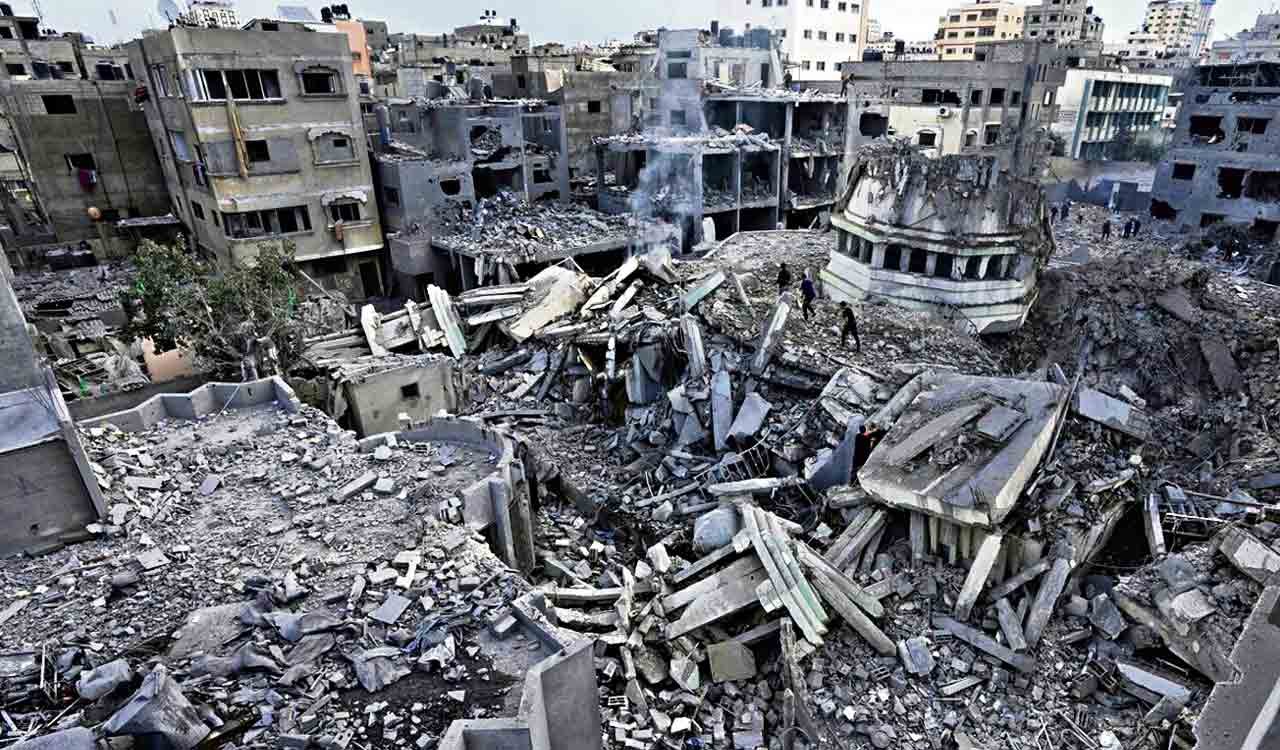Though Iran says it does not want to be involved in a wider conflict, groups in its ‘Axis of Resistance’openly proclaim their solidarity with Palestinians
Published Date – 19 February 2024, 11:59 PM

By B Vinay Kumar
The ongoing Israel-Palestine conflict has triggered several unprecedented geopolitical developments in the Middle East and also in other parts of the world. Unlike the Russia-Ukraine conflict, the Israel-Palestine conflict has a long historical and ethnic rivalry. When British forces conquered the Palestine region from the Ottomans in 1917, the Jewish population was around 6% in the regions of Palestine and Transjordan. In 1917, the Balfour Declaration was adopted by Britain which officially accommodated Jewish people in Palestine without any clear geographical demarcations. The British mandate continued for up to three decades amid protests, riots and violence by the Jewish and Arab Palestinians.
Rooted in History
In 1947, the United Nations developed a partition plan for Palestine, which proposed granting 45% of the land to the Arabs and 55% to Israel. The cities of Jerusalem and Bethlehem should be under the United Nations or international control. The resolution was supported by 33 nations, opposed by 13, and 10 nations abstained from voting. Finally, the United Nations partition plan for Palestine was passed in 1947 by terminating the British mandate.
Unfortunately, the partition plan proposed by the United Nations was never implemented, and immediately after two weeks, the first Arab-Israel war broke out. Israel was compelled to fight this war alone with Palestinian Arabs and four other powers — Egypt, Syria, Jordan, and Iraq. After 10 months, Israel gained nearly 60% of the territory. The plans of the Arabs backfired; Israel gained more territories and became stronger in military and technological spheres within a short period.
To understand the backdrop of the sudden attack of Hamas on Israel on October 7 last year, it is vital to consider the internal political scenario of Israel.
Political instability in Israel erupted when Prime Minister Benjamin Netanyahu was charged with bribery and fraud in three different cases. But he was projected as the only competent leader to protect the vulnerable nation surrounded by long-term enemies. Thus, he was re-elected as Prime Minister in his sixth consecutive term of office and decided to initiate several reforms in the judiciary and separation of powers to weaken the voice of the opposition. This received widespread criticism and turned into a huge protest movement. Even his Defence Minister Yoav Gallant raised his voice against the controversial judicial reforms.
Hamas, the outfit fighting for the cause of Palestine, took advantage of the country’s internal political developments and planned a sudden attack. Israel’s defence and intelligence systems failed to prevent the attacks as they were focused on internal political developments.
First Warfront
The First Warfront was opened when the Israeli Defense Forces (IDF) were not in active mode. Hamas-led forces of Palestine Islamic Jihad, DFLP, PRC, and PFLP launched air and land attacks. Hamas launched at least 3,000 rockets into the territories of Israel and simultaneously started ground attacks on Israeli military and civilian communities by breaching the border fencing between Israel and the Gaza Strip. Hamas abducted 250 Israeli civilians and other nationals, including 30 children. Tensions escalated and led to a large-scale war against Hamas by the IDF.
The IDF initiated a systematic wartime preparedness by formulating a defence strategy “Operation Iron Swords”. The IDF attack began with a cautionary call for civilians to evacuate north Gaza, where most of the Hamas shelters are located. In ground operations, the IDF released a series of video footage of Hamas’ strategies for war preparedness, and underground tunnels were revealed to the outside world. It also exposed how Hamas used civilians as human shields as they established their rocket launch centres near schools, hospitals, mosques, etc. Another hard fact about Hamas is that none of its leader resides in the Palestine region, as it was recorded among the top five affluent terrorist organisations in the world.
Other Warfronts
The Second Warfront was launched when Hezbollah, another terrorist organisation from Lebanon, which is a close neighbourhood country of Israel, started airstrikes on Israel in support of Palestinian Arabs and Hamas, against the IDF. It was a challenging war for the IDF to face a dual-front war between the Gaza Strip and Lebanon.
The Third Warfront was initiated by the Houthis. This Islamic rebel group from Yemen suddenly entered into the picture by attacking freight ships sailing through the Red Sea, which has one of the primary global maritime choke points known as the Bab-el-Mandeb Strait. This has created global trade disruption and a crude oil price hike as this sea route transports nearly 12 per cent of the shipping traffic. Around 8 per cent of liquefied natural gas (LNG) cargoes passed through this sea route in 2023. The US retaliated by launching a joint operation with 20 nations under ‘Operation Prosperity Guardian’, a military multinational coalition similar to NATO. However, it is too early to assess the role of this operation.
Subsequently, as a spillover effect, another military attack was launched as a Fourth Warfront in the region by Iran on Pakistan, Iraq and Syria. These attacks by Iran fueled tensions in the Middle East region. Paradoxically, Iran said that it does not have the intention to be involved in a wider conflict among all these active war fronts in the region. However, groups in its so-called ‘Axis of Resistance,’ which include Houthi militants, Hezbollah of Lebanon, and other groups in Syria and Iraq, openly proclaimed their solidarity with Palestinians against Israel. In this connection, it is difficult to predict how many war fronts will come up and in which direction the conflict will take a turn.





